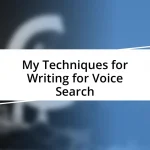Key takeaways:
- Long-form content, exceeding 1,200 words, fosters deeper engagement and enhances understanding through comprehensive analysis and relatable storytelling.
- Effective structuring techniques, including planning, multimedia integration, and a conversational tone, improve reader navigability and connection.
- Success measurement relies on engagement metrics, social shares, comments, and qualitative feedback, highlighting both quantitative and real-world impacts of the content.

Understanding Long-Form Content
Long-form content is typically defined as articles or pieces that exceed 1,200 words, designed to provide in-depth analysis or storytelling. I remember the first time I dove into writing a piece that was over 2,000 words. I felt a mix of excitement and apprehension—would my audience stay engaged, or would they find it too overwhelming? It was a real turning point for me, as I learned that depth often leads to richer insights.
When crafting long-form content, I’ve found that it’s essential to create a narrative that feels cohesive and engaging. For me, using subheadings and bullet points not only organizes the information but also breaks the monotony, making it easier for readers to grasp complex ideas. Have you ever read a lengthy article that lost your attention midway? I realized that maintaining a strong thread throughout the piece helps keep readers hooked, and that’s what I strive to achieve in my writing.
One of the most rewarding aspects of long-form content is how it allows for storytelling and personal connection. In my experience, sharing anecdotes or vignettes can transform abstract concepts into relatable experiences. I recall sharing a heartfelt story about overcoming a challenge, and the feedback was overwhelming; readers appreciated the vulnerability and felt a bond over shared struggles. It made me think—how often do we underestimate the power of our own narratives in driving engagement?

Benefits of Long-Form Content
Long-form content offers a wealth of benefits that go beyond just word count. In my experience, one of the most significant advantages is the ability to rank better in search engines. I once wrote a detailed guide on a niche topic, and to my surprise, it consistently drew organic traffic long after I published it. This longevity is a game-changer for reaching new readers and building credibility over time.
Here are some key benefits of long-form content:
- Deeper Engagement: Readers tend to spend more time on well-crafted long-form articles.
- Improved SEO: Search engines favor comprehensive content that answers user queries effectively.
- Authority Building: In-depth content establishes you as an expert in your field.
- Greater Shareability: Comprehensive articles often get shared more frequently on social media.
- Endurance Over Time: Long-form pieces can continue to attract traffic and generate interest long after publication.
Another clear benefit is that long-form content encourages critical thinking and deeper understanding. I recall writing an extensive piece on digital marketing strategies where I really delved into the various tactics. Not only did I challenge myself to think beyond surface-level tips, but I also noticed that readers appreciated the nuances and complexities I explored. It felt gratifying to help my audience broaden their perspectives, and that connection created a loyal readership eager for more insights.

Techniques for Writing Long-Form Content
When it comes to writing long-form content, planning is half the battle. I’ve found that developing a detailed outline before I start writing is incredibly helpful. It keeps my thoughts organized and ensures that I cover all necessary points without veering off track. Do you remember the last time you felt lost in a lengthy article? An outline can steer both the writer and the reader in the right direction.
Another effective technique is incorporating multimedia elements, such as images, infographics, or videos, within the text. In my experience, these elements not only break up long sections of text but also provide visual context that enhances understanding. I once included an infographic in one of my articles, and the feedback was overwhelmingly positive—it sparked more engagement and even led to discussions in the comments section. It made me realize how visuals can create a richer reading experience that resonates with diverse audiences.
Lastly, don’t underestimate the power of storytelling—both personal and narrative-driven. I remember sharing a challenging project I undertook at work and the lessons I learned along the way. This not only added a personal touch but also illustrated my main points effectively. Readers often connect with stories on a different level, fostering a sense of empathy and relatability. How do you weave stories into your writing? For me, it’s all about being authentic and vulnerable, which invites readers to journey with me through the content.
| Technique | Description |
|---|---|
| Planning and Outlining | Creating a structured outline helps keep your writing focused and organized. |
| Multimedia Elements | Incorporating visuals enhances engagement and understanding. |
| Storytelling | Sharing personal anecdotes fosters connection and relatability. |

Structuring Your Long-Form Content
When structuring long-form content, it’s essential to find a balance between comprehensive coverage and reader navigability. I personally prefer starting with a clear introduction that outlines what the reader can expect. This approach not only sets the tone but also piques curiosity. Have you ever clicked away from a piece because the beginning didn’t grab your attention? I’ve been there, and it’s why I make a conscious effort to create engaging openings.
Utilizing subheadings is another effective strategy I’ve embraced. Breaking up the text into digestible sections allows readers to easily skim for relevant information. For instance, during a recent project on sustainable living, I used subheadings to guide readers through different lifestyle changes. It was rewarding to see them comment about how the structure made it easier to digest the information. Isn’t it satisfying when readers appreciate the effort we put into clarity?
Finally, keeping a consistent tone throughout the content is crucial. I always aim for a conversational style that mirrors how I would speak to a friend, which helps build rapport with the reader. When I revised an article on productivity hacks, I noticed that when I maintained this friendly tone, readers were more likely to engage in discussion. How do you adapt your tone to foster connection? For me, it’s a blend of professionalism and warmth that invites readers to share their thoughts.

Engaging Your Audience Effectively
Engaging your audience effectively is a balancing act that I’ve learned to master over time. I recall a time when I hosted a webinar and realized how interactive elements transformed the atmosphere. When I invited participants to share their thoughts in real time, it was like igniting a spark. The lively exchanges made us feel like a close-knit community, and I saw firsthand how audience involvement can pivot the entire dynamic from passive listening to active participation.
Another aspect I’ve found crucial is using open-ended questions throughout my writing. For example, when I wrote about my journey in digital marketing, I asked readers to consider their own experiences. This not only encouraged them to reflect but also brought a personal touch to the piece. It’s amazing how something as simple as a question can trigger thoughts and discussions. Have you ever noticed how engaging a well-placed question can be? It’s a small change that invites readers to become more than just spectators; they start to see themselves within the narrative.
Finally, I emphasize the importance of personal connection in my content. I once shared my struggle with imposter syndrome in an article, and the response was overwhelming. Many readers reached out to share their stories, creating an unexpected bond. When I openly discussed my vulnerabilities, it helped build trust and a sense of community. Have you considered how sharing your own battles could resonate with readers? Authenticity is a powerful tool, and by revealing a little of myself, I found that I could truly engage my audience on a deeper level.

Measuring Success of Long-Form Content
Measuring the success of long-form content can seem daunting at first. I’ve found that analyzing engagement metrics like time on page is crucial. For instance, during one of my recent articles about personal finance, I noticed that readers lingered longer than usual, which suggested they were genuinely interested in the material. What do those metrics scream to you about your content’s effectiveness?
Another valuable approach is to monitor social shares and comments. I remember publishing a comprehensive guide on mental health and being pleasantly surprised by the influx of shares across social media. Each share felt like a small victory, indicating that people found the piece worthy of their network’s attention. Have you ever had that satisfying moment when you realize your work is resonating beyond your immediate audience?
Also, I can’t overlook the importance of qualitative feedback. After releasing my long-form content on nutrition, a reader reached out to share how the insights inspired her to change her eating habits. That kind of direct feedback reinforces my belief that success isn’t just in numbers; it’s also about the real-world impact we have on others. How do you define success in your writing journey? Sometimes, it’s those heartfelt messages that speak volumes.














